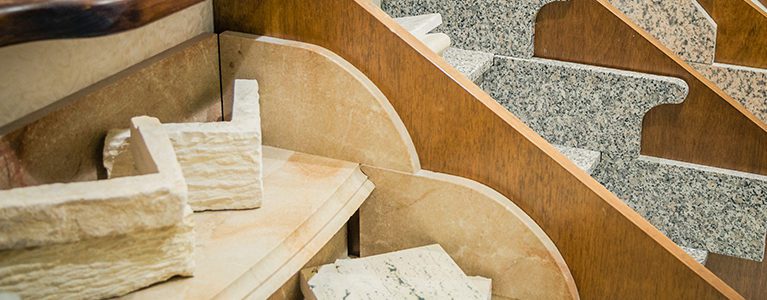
Natural stone is sure to boost the value of your home, adding elegance and beauty while remaining less expensive than many other cladding materials. Natural stone is durable and simpler to maintain than you would expect, provided you keep up with necessary maintenance and upkeep.
When it comes to natural stone—as with any material—wear and tear happens, and we want you to be prepared to recognize and identify the type of damage and how to treat it. Natural damage and decay can occur in tropical climates with warm weather, humidity, sea breeze, and lots of sunlight—just like Florida.
What damages can take place to your natural stone?
Your natural stone—whether it be on your floor, on your counter, on your pool deck, or as decorative pieces throughout your home—will experience wear and tear and some possible accidental events.
Certain spills—such as red wine on a white natural stone countertop—can wreak havoc and leave you with a nasty stain.
Many stones are porous and absorb liquids quickly. Discoloration may result from many liquids spilling onto the surface of your stone. When a spill happens, be sure to blot the spill up right away with an absorbent cloth. Do not rub it!
Be sure that you do not use any harsh cleaning agents that contain acid, such as bathroom cleaner, tub and tile cleaners, grout cleaners, lemon juice, or vinegar. These can significantly damage your natural stone. Instead, rinse with water and dry the area thoroughly.
To remove a stain, make sure the area is free of any debris. After blotting the area, flush it with water and a mild soap many times. Then, dry the area completely. Depending on the type of stain, removal may be more difficult.
An oil-based stain will usually darken the surface of your natural stone and to remove it, it must be chemically dissolved. Organic stains from fruit, coffee, and other food will leave behind a pink/brown stain and will go away once the source is removed. When outdoors, the natural sunlight will usually naturally remove the stain for you.
When a stain is not organic and is a metal stain from iron or rust, they will appear orange/brown and may be extremely difficult to remove. Biological stains from things such as mildew can be removed by diluting certain cleaning agents with water. However, it will be important that you ensure the cleaner is safe to use on your stone.
Ink stains from markers and pens can be removed with bleach, provided it is safe to use on the stone’s surface. Paint stains can be removed with lacquer thinner or even scraped off very carefully with a razor blade. Water stains will usually leave behind water rings and can be buffed out with steel wool.
There are many kits available to assist with chips, depending on what type of natural stone you have. Before using a kit, make sure to clean the area thoroughly before applying anything with a safe cleaning agent for your stone.
After aging and wear and tear, your natural stone may become slightly dull and lose its sense of shine and luster. Specifically, high traffic areas can dull faster and will require more frequent attention and care. Also, using cleaning products that are not safe for a particular stone can reduce the luster and lead to dullness.
Fortunately, dull natural stone can absolutely be restored. First, make sure that you do not have a film, such as a soap film, on your countertop or floor. Using a mild soap and water to clean your counters and flooring may leave behind a film that takes away from the natural shine and creates a buildup over time. You can use a polishing powder to treat problem areas.
Refinishing your natural stone will involve honing and polishing and will restore the finish of your stone and should be done by a professional.
There are two types of water damage to natural stone: hard and soft. When hard water gets to natural stone, mineral deposits that wind up on the surface of your stone. Soft water can damage the actual structure of your stone.
Water damage can leave behind a white residue; this is most likely a calcium residue. In cases of severe water damage, the stone’s top sealer will need to be removed to allow the stone to breath and for the moisture to evaporate. Any discolorations or damage will be repaired, and then the natural stone will need to be resealed.
Now that we have examined some common problems that natural stone surfaces face, we will discuss some of the most popular types of stone we service and cleaning tips for each:
Marble is not as hard as granite, and is a bit more porous, making it more prone to water damage. Marble is a natural stone that has an extremely sophisticated appeal to it and comes in many different colors with a huge variety of vein patterns.
If you are planning on using this natural stone outdoors, it will certainly need to be sealed because it is very porous. Also, a non-slip finish will be beneficial to prevent accidents from happening. When it comes to cleaning, avoid generic cleaners that can damage the stone.
Quartzite, a 100% naturally occurring stone has risen dramatically in popularity in the past few years. It is extremely durable and affordable.
Quartzite is popular in subdued colors but can come in light shades of green or pink as well. It has many veining patterns. Cleaning quartzite should be handled in a very delicate way, avoiding harsh cleaning agents.
Limestone is also very porous and will need to be sealed. The texture of limestone is what sets it apart from all other stones. The material has little “pits” in the surface, creating a distinct “feel.”
With limestone, you can opt for a tumbled finish or a polished finish. The coloration of this stone is very subdued, giving off an “earthy” vibe.
one.